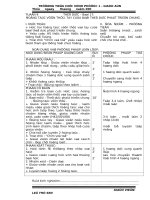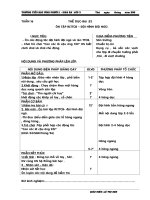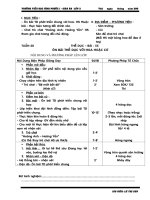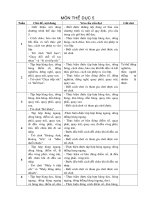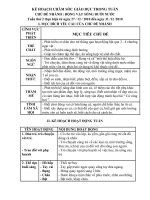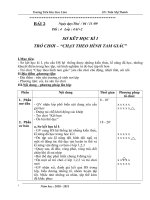Tài liệu Reforming Mil-Specs - The Navy Experience with Military Specifications and Standards Reform docx
Bạn đang xem bản rút gọn của tài liệu. Xem và tải ngay bản đầy đủ của tài liệu tại đây (88.84 KB, 40 trang )
PREFACE
This documented briefing (DB) describes a RAND study conducted in
response to a November 1998 Navy request for help in determining why its
military specifications and standards reform (MSSR) efforts appeared to be
underfunded. The study had four objectives: first, to define the status of
Navy military specification and standards reform as of approximately
December 1998; second, to find possible explanations for why, as of
December 1998, the Navy had not met its self-imposed target date for
MSSR completion; third, to describe the primary options for MSSR com-
pletion available to the Navy’s Acquisition Reform (AR) Office; and fourth,
to suggest further steps RAND might take to inform the Navy’s choice of
options.
From December 1998 through March 1999, interviews and data collection
efforts were undertaken with personnel from the Navy AR Office, NAVSEA,
and NAVAIR. In addition, officials in the U.S. Air Force, U.S. Army, Defense
Logistics Agency, and Office of the Secretary of Defense were interviewed.
Initial analysis and assessment of the data were completed by the end of
February 1999, and findings were presented to the sponsor in the form of a
briefing on 5 March 1999. RAND’s initial findings were accepted by the
sponsor, and one of the options chosen as the solution to completing
implementation of Navy Mil-Spec reform. As a result, the sponsor invited
RAND to attend a meeting of the systems command (SYSCOM) standardi-
zation executives on 16 July 1999 in order to present the findings and assist
in implementation approaches as needed. This DB documents the briefing
that was presented to Navy officials at both the March and July 1999 meet-
ings.
Although this documented briefing describes and analyzes a specific situ-
ation faced by the Navy in 1998-1999, RAND believes that MSSR has pro-
iii
iv
foundly affected the acquisition environment for all the services, in ways
that are not all yet fully understood. By shedding light on some potential
future issues raised by military standards reform, the research presented
here remains timely and still should be of interest to service, defense
agency, and OSD personnel concerned with weapon system acquisition
and military acquisition reform.
This research was conducted for the U.S. Navy Acquisition Reform
Executive within the Acquisition and Technology Policy Center of RAND’s
National Defense Research Institute, a federally funded research and devel-
opment center sponsored by the Office of the Secretary of Defense, the
Joint Staff, the Unified Commands, and the defense agencies.
ACKNOWLEDGMENTS
During the course of this project, many people generously provided us with
and helped us to gain access to information and data. We would especially
like to acknowledge Captain Sam Collins, U.S. Navy Standardization Office,
Office of the Assistant Secretary of the Navy for Research, Development
and Acquisition; Ms. Paula Howard, U.S. Navy Standardization Office; Mr.
Jeff Allan and Mr. Tom O’Mara, Naval Air Systems Command; Mr. David
White, Naval Sea Systems Command; Mr. Stephen Lowell and Mr. Bill Lee,
Defense Logistics Agency; Mr. Lynn Mohler, U.S. Army Standardization
Office; and Mr. Clark Walker and Major Walter Hallman, U.S. Air Force
Standardization Office. Dr. Giles Smith, of RAND, provided helpful com-
ments and suggestions on an earlier draft. We emphasize, however, that the
content and conclusions of this documented briefing are entirely our own.
vii
In November 1998, the U.S. Navy (USN) asked RAND for assistance in
determining why funding for ongoing military specifications and stan-
dards reform (MSSR) efforts in the Navy appeared to be inadequate for the
task, and in light of that answer, to describe some likely options for funding
and completing the MSSR task. In response, we collected data from and
held discussions with various Department of Defense (DoD) officials
involved in the reform process in order to understand the perspectives,
interests, and concerns of the various actors. The initial interviews were
conducted with officials in the Navy Acquisition Reform (AR) and System
Command (SYSCOM) organizations; we also spoke with officials from the
Air Force, Army, Office of the Secretary of Defense (OSD), and Defense
Logistics Agency (DLA).
This documented briefing defines the status of Navy reform efforts as of
approximately December 1998. It describes the processes used by the
SYSCOMs to perform reform activities and by AR to provide oversight and
guidance to SYSCOM efforts. Comparing Navy, Army, and Air Force MSSR
processes, it outlines four hypotheses that might explain why, as of
December 1998, the Navy appeared to have had less success than the other
services at completing MSSR. It concludes by outlining options available to
the USN AR Office for MSSR completion, and describing steps RAND might
take to inform the USN AR’s choice.
1
R
1
Completing U.S. Navy Military
Specifications & Standards Reform
(MSSR): Issues and Problems
2
We begin by briefly reviewing the role of MSSR in DoD’s AR strategy. We
then describe the nature of the Navy’s MSSR situation, and compare the
document disposition strategies adopted by the Air Force and Army with
those adopted by two Navy SYSCOMs, NAVAIR and NAVSEA. We chose to
examine NAVAIR and NAVSEA because these two SYSCOMs, which have
traditionally owned the vast majority of the Navy’s military specifications
(Mil-Spec) and military standards (Mil-Std) documents, also have the fur-
thest to go towards completion of MSSR.
On the basis of this comparison of document dispositions, we formulate
four separate but not mutually incompatible hypotheses to explain why
MSSR outcomes differed across the services. We then suggest three basic
options for resolving the Navy’s MSSR funding and implementation prob-
lem. We conclude by identifying the additional data and analysis required
for determining which of these options is likely to be optimal for the Navy.
R
Outline
2
• The role of MSSR in the Department of Defense’s
(DoD) Acquisition Reform (AR) strategy
• The USN Problem: Budget and schedule
• Dispositions compared: NAVAIR, NAVSEA, USAF,
USA
• Hypotheses explaining differences in outcomes
• Basic options for resolving the problem
• Determining the best option(s)
• Additional data & research support requirements
3
1
Outside of the services themselves, DLA is the DoD organization with the largest procure-
ment responsibility. DLA handles most of the services’ commodity purchases.
In his June 1994 memo, “Specifications and Standards: A New Way of Doing
Business,” then Secretary of Defense William Perry mandated the virtual
elimination of Mil-Specs and Mil-Stds by directing the services and rele-
vant defense agencies to “use performance and commercial specifications
and standards instead of military specifications and standards, unless no
practical alternative exists to meet the user’s needs.”
1
MSSR was—and still
is—seen as a critical enabler in an approach to acquisition that is all in all
more commercial-like. Elements of a commercial-like approach include
the exploitation of dual-use technologies, components, and processes that
are better and cheaper than their military-unique counterparts; the adop-
tion of cost-effective commercial business practices; the achievement of
commercial economies of scope and scale in R&D and production through
the exploitation of dual-use facilities; and the elimination of the cost-pre-
mium associated with unnecessarily burdensome government regulations,
including Mil-Specs and Mil-Stds.
R
MSSR: A Critical Underpinning of DoD’s
Integrated AR Strategy
3
• June 1994 Perry memo makes MSSR centerpiece of
AR
• OSD seeks commercial-like approach emphasizing
dual use and focused on cost effectiveness to
– Exploit cheaper, better commercial technologies,
components, processes
– Adopt more efficient commercial business practices
– Achieve R&D and production synergies of an integrated
industrial base
– Eliminate USG-unique compliance costs
• MSSR is critical enabler (?)
4
As suggested by several studies, including some performed by RAND, the
cost savings from adopting a more commercial-like approach to acquisi-
tion in general, and to adopting MSSR in particular, can be significant.
2
The
chart above gives two examples of the differences in schedule and cost for
Mil-Spec and commercial grade parts considered for the Eaton AIL
Division family of modular radars.
The left side of the figure compares prices for a Mil-Spec and an industrial
grade Pulse Compression Network, a custom-designed radio frequency
part. Two parts versions are shown, the Dash-1 and Dash-2. The industrial
grade and Mil-Spec versions of the part are identical in performance, but
not in recommended temperature range, resistance to humidity and vibra-
tion, and so forth.
3
The industrial grade parts are about 40 percent cheap-
2
See, for example, Mark Lorell and John C. Graser, An Overview of Acquisition Reform Cost
Savings Estimates, Santa Monica, Calif.: RAND, MR-1329-AF, 2001. The examples presented
here borrow from Mark Lorell, Julia Lowell, Michael Kennedy, and Hugh Levaux, Cheaper,
Faster, Better? Commercial Approaches to Weapons Acquisition, Santa Monica, Calif.: RAND,
MR-1147-AF, 1999.
3
In particular, serious performance degradation problems have been encountered at tem-
peratures below –30°C. For effective operation in cold environments below –30°C, the AIL
modules will have to be protected or different parts will have to be used.
R
Cost Savings on Custom-Designed Radar
Components Are Significant
4
Military grade
(6 months
delivery
Industrial grade
(4 months
delivery
Consumer grade
(AIL Modular Radar Prototypes)
Dash-1 Dash-2
Pulse Compression Network
(RF-type part)
Power Supply
Unit
cost
(1,000 $)
14
12
10
8
6
4
2
0
5
er than the Mil-Spec parts. Further, they take one-third less time for deliv-
ery.
The right side of the figure compares the price of a custom-designed Mil-
Spec power supply component to a consumer grade component with the
same design and performance characteristics. The consumer grade com-
ponent costs about 20 percent less.
6
Numerous Mil-Spec electronics parts are manufactured on dual-use com-
mercial lines and are in fact identical to commercial parts. But these parts
can differ enormously in price because of the extensive screening and test-
ing required of Mil-Spec parts. Commercial vendors or their manufacturing
processes are often qualified by the system integrator, but not each and
every part they produce. Mil-Spec parts on the other hand are individually
subjected to rigorous testing that greatly increases their cost. Much of the
Mil-Spec cost premium derives from the extensive testing and screening of
Mil-Spec parts and components.
The figure above shows the basic ten-item lot cost for two parts investigat-
ed by AIL for its Modular Radar program, plus the cost of screening. The left
side of the figure shows two RF mixers, one Mil-Spec and one consumer
grade. The basic ten-part lot cost for both is $410. However, for the Mil-
Spec version, the vendor adds a lot charge plus $15,000 for screening the
parts. Further, while the commercial RF mixer was in stock and immedi-
ately available, the Mil-Spec version required at least four months for deliv-
ery.
R
Huge Cost Premiums Are Paid
for Mil-Spec Parts Screening
5
Military grade:
Basic lot cost
Consumer grade:
Basic lot cost
Screening (per lot)
Testing
Fixturing
(AIL Modular Radar Prototypes)
RF Mixer Digital Integrated
Circuits
(750-1, 751-1)
Cost ($)
(10 part
lot)
18,000
16,000
14,000
12,000
10,000
8,000
6,000
4,000
2,000
0
*Excludes lot charge
$15,410*
$18,210
$3,210
$2,100
$100
$850
$1,210
$410 $410
7
The right side of the figure shows two Mil-Spec digital integrated circuits
used by AIL in its modular radars. The vendor had discontinued manufac-
ture of these Mil-Spec parts, but the nearly identical consumer grade ICs
were available for ten to twenty dollars each. To deliver the Mil-Spec part,
the vendor asked for $121 for the die per IC, plus $2,000 for fixturing, and
$17,000 for repackaging and testing the IC. Instead, AIL decided to buy the
consumer grade parts, which are encapsulated in plastic, and conduct its
own limited temperature tests. This testing cost $750 for fixturing and
$1,250 for lot testing. By adopting this approach, AIL was able to purchase
a small lot of 10 parts for less than one-eighth the cost of a ten-part Mil-
Spec lot.
8
Given the centrality of Mil-Spec reform to DoD’s overall efforts to achieve
acquisition reform, what then were the issues and problems surrounding
the Navy’s attempt to implement MSSR? Discussions with Navy officials
involved in MSSR revealed three primary problems.
First, the Navy missed the services’ self-imposed completion date of
October 1998 for MSSR. At the beginning of Fiscal Year (FY) 1999, the Navy
had completed just 50 percent of the document actions it specified during
its initial assessment of what to do with approximately 8500 Mil-Spec and
Mil-Std documents. By way of comparison, both the Army and Air Force
had essentially completed their respective document actions as of October
1998.
Second, most of the document actions taken by the Navy as of October
1998 consisted either of canceling documents or inactivating them for new
designs. These are relatively easy and inexpensive actions compared to the
challenge and cost of writing military performance specifications or revis-
ing and updating documents in accordance with commercial specifica-
tions, both of which will be required if the original document dispositions
are not changed.
R
Problem Definition
6
• Missed self-imposed Oct 98 MIL-SPEC Reform completion date
• Remaining actions relatively more costly and take more time
• Funding requests of SYSCOMS significantly greater than available funds
for FY99 and beyond
Request
Available
NAVAIR Marine
Corps
Unit
cost
(1,000 $)
NAVSUPNAVFACSPAWARNAVSEA
16,000
14,000
12,000
10,000
8,000
6,000
4,000
2,000
0
FY99 Funding
9
Third, the original planned Navy budget for MSSR has already mostly been
spent, and new funding for MSSR is unavailable after FY99. There is a sig-
nificant shortfall between budgeted funds and the funds needed to com-
plete MSSR as estimated by the SYSCOMs. As shown in the figure above, in
FY99 the projected budget for NAVSEA and NAVAIR for completion of
MSSR is less than half of what these SYSCOMs had requested.
10
DoD’s Acquisition Streamlining and Standardization System (ASSIST), a
database system for DoD-wide standardization document information
management, lists five possible document disposition categories:
• Cancel;
• Inactivate for new design;
• Convert to commercial;
• Convert to performance; and
• Retain and update.
4
According to ASSIST, as of December 1, 1999, the Navy had completed most
of its planned dispositions in the “Cancel” and “Inactivate” categories.
About half of the documents it intended to convert to performance speci-
fications had been converted. However, less than a sixth of the documents
so designated had been either converted to commercial standards and
specifications or retained and updated.
4
The ASSIST database provides a useful, standardized record of DoD document manage-
ment. However, it does not explicitly track service or SYSCOM decisions to transfer prepar-
ing activity (PA) for a document to other DoD agencies. As discussed below, some services
and some Navy SYSCOMs took full advantage of the MSSR option to transfer PA. For this
reason much of the data we use in our later analysis come from sources other than ASSIST.
R
Status of USN MSSR Actions by
Disposition Categories
7
# of
actions
Note: total
adds to
6086;
disposition
of
remaining
2,483
unknown
Source: ASSIST database 12/1/98
Completed
TBD
Cancelled
Inactivate
for new
design
Convert
to
commercial
Convert to
performance
Retain
and
update
1800
1600
1400
1200
1000
800
600
400
200
0
11
At the beginning of MSSR, two SYSCOMs—NAVAIR and NAVSEA—
“owned” far and away the largest number of Mil-Spec and Mil-Std docu-
ments in the Navy. According to ASSIST, as of December 1, 1998, they were
also the furthest from completing their new document dispositions in
terms of absolute numbers.
5
As illustrated in the chart above, as of
December 1, 1998, NAVAIR and NAVSEA each had over 1,200 document
actions left to complete, while NAVSUP, NAVFAC, and the Marine Corps
had under 200 document actions to go, and SPAWAR had essentially com-
pleted its task.
5
However, they were not furthest from completion in percentage terms: As of December 1,
1998, both NAVAIR and NAVSEA had completed well over 50 percent of their document con-
versions, while NAVSUP and NAVFAC had completed less than half of theirs.
R
Status of MSSR Actions by SYSCOM
8
Completed
TBD
NAVAIR Marine
Corps
Other
Number
of
documents
(actions)
NAVSUP NAVFACSPAWAR NAVSEA
2000
1800
1600
1400
1200
1000
800
600
400
200
0
Source: ASSIST database 12/1/98
12
As of December 1, 1998, NAVAIR had completed the transition for the
majority of its documents in the “Cancel” and “Inactivate for new design”
categories. Roughly half of the documents in the “Convert to performance”
category had been converted, while substantially less than half of the doc-
uments in the “Convert to commercial” and “Retain and update” categories
were done.
For NAVSEA, the majority of the documents in the “Cancel” and “Inactivate
for new design” categories had been completed. NAVSEA had many more
documents in the “Convert to performance” category than NAVAIR, and
slightly less than half of these had been converted by December 1, 1998.
Substantially less than half of the documents in the “Convert to commer-
cial” and “Retain and update” categories were complete.
R
NAVAIR and NAVSEA Status by Category
9
Number
of
documents
(actions)
Number
of
documents
(actions)
Source: ASSIST database 12/1/98
Completed
TBD
Cancelled Inactivate
for new
design
Convert
to
commercial
Convert to
performance
Retain
and
update
900
800
700
600
500
400
300
200
100
0
800
700
600
500
400
300
200
100
0
NAVAIR
NAVSEA
13
When MSSR was first inaugurated by Dr. Perry in June 1994, his memo con-
tained no detailed guidelines for implementation. The services—and rele-
vant defense agencies such as DLA—developed their own approaches to
implementation, approaches that were affected by differences in their
organizational structures, the nature of their leadership, and their individ-
ual organizational “cultures,” as well as by other factors. As a result, the final
document dispositions chosen by the Air Force, Army, and Navy—and
within the Navy, NAVAIR, and NAVSEA—differed markedly from each
other.
These differences help to explain why the Navy lagged behind the other
services in completing MSSR by the self-imposed October 1998 deadline.
They also suggest various hypotheses as to why MSSR implementation has
proceeded more slowly in NAVAIR and NAVSEA than in the other Navy
SYSCOMs and other services.
R
Differing MSS Dispositions Help Explain
Schedule Differences
10
• June 1994 Perry memo contained no guidelines for
implementation
• Services developed their own implementation
strategies
• Implementation approach affected by differences in
service organizational structure, leadership,
strategies, acquisition “culture”, & other factors
• Significantly differing final MSS dispositions
• Examination of dispositions helps explain schedule
differences and suggests various hypotheses
regarding different outcomes
14
To operationalize the Perry memo, OSD identified six broad categories of
possible document actions and asked the services and defense agencies
responsible for preparing activity to decide in which of the categories their
documents belonged. For each service, the six possible disposition cate-
gories were:
• Keep as detailed military specification (Detail Spec)
6
;
• Convert to military performance specification (Performance or
Mil-Prf)
7
;
• Convert to non-governmental standard (NGS);
• Transfer preparing activity (Transfer PA);
• Inactivate for new procurement; and
• Cancel.
Note that these document disposition categories differ from those includ-
ed in the ASSIST database because they include the category “Transfer PA.”
6
Includes test method and manufacturing process and design criteria standards and hand-
books as well as detailed and federal specifications.
7
Includes interface and standard practice standards, specifications, and commercial item
descriptions (CIDs).
R
Pre-Reform Mil-Spec/Stds
and MSS Dispositions by Organization
11
DETAIL SPEC
PERFORMANCE
NGS
TRANSFER PA
INACTIVATE
CANCEL
NAVSEA
Number of documents
USANAVAIR USAF
14000
12000
10000
8000
6000
4000
2000
0
Sources: Various reports on MSSR status by the USN SYSCOMS, Air Force, and Army.
15
Most of the documents in this category were designated for transfer to
DLA, which, as part of MSSR, formally requested that the services transfer
PA for most commodity items it was already responsible for ordering.
As shown in the figure above, NAVSEA and NAVAIR’s failure to complete
MSSR by the self-imposed October 1998 deadline cannot be explained sim-
ply by the large number of documents for which they were responsible.
Prior to MSSR, NAVAIR and NAVSEA managed approximately 8,000 docu-
ments combined, with NAVSEA alone responsible for roughly the same
number of documents as the Air Force, which had about 4,000. However,
according to various service briefings and databases tracking the status of
MSSR, prior to June 1994 the Army had approximately 12,000 Mil-Spec and
Mil-Std documents to manage, the largest number of all the services.
8
As
mentioned above, both the Air Force and Army for the most part met the
October deadline.
Instead, the probable explanation for the schedule differences across serv-
ices lies in initial differences in the document dispositions they chose.
8
The data presented here are derived from various service briefings and databases that are
not entirely consistent with each other. In a few cases, we have used our own judgment to
assign Army and Air Force document actions to MSSR disposition categories consistent with
those used by NAVAIR and NAVSEA. The broad pattern of the data is robust to any errors
that may have been introduced as a result of this approach.
16
The disposition categories that have the highest workload are those that
require expensive and time consuming updates or conversion of Mil-Specs
and Mil-Stds. The lowest workload categories are those involving the can-
cellation or inactivation of documents, or the transfer of document prepar-
ing authority. Many times, dispositions to these low workload categories
can be achieved with the stroke of a pen.
As shown in the figure above, more than 40 percent of NAVSEA and NAVAIR
documents fell into the three high workload categories, with NAVSEA plac-
ing proportionately more into the “Performance” category and NAVAIR
placing proportionately more into the “NGS” category. For NAVSEA in par-
ticular, the “Transfer PA” category was a tiny fraction of the total.
In contrast, the Army and Air Force placed proportionately more of their
documents in the three “low workload” categories than did either NAVSEA
or NAVAIR. For example, over 90 percent of Air Force documents were
placed in the “Cancel,” “Inactivate,” and “Transfer PA” categories. The
“Transfer PA” category alone accounted for over 60 percent of Air Force
documents, most of which were given to DLA. The Army also transferred
over 30 percent of its documents, but chose to inactivate an even higher
proportion (37 percent).
R
Mil-Spec/Stds Disposition Percentages:
Comparing Workload Categories
12
DETAIL SPEC
PERFORMANCE
NGS
TRANSFER PA
INACTIVATE
CANCEL
NAVSEA USANAVAIR USAF
100%
90%
80%
70%
60%
50%
40%
30%
20%
10%
0%
Sources: Various reports on MSSR status by the USN SYSCOMS, Air Force, and Army.
PRF includes Interface & STD Practice STDS, SEPCS, and CIDS. DETAIL, Includes Test Method,
MFG Process, & Design Criteria STDS, HDBKS, DTL & FED SPECS
17
One outcome of the adoption of differing approaches to MSSR implemen-
tation, therefore, has been both a reduction and a redistribution of docu-
ment preparing activity by and among the services and various DoD agen-
cies. At the beginning of MSSR in June 1994, there were approximately
41,000 MSS documents. Of these, the largest percentage were owned by the
Army (approximately 36 percent), followed by the Navy (33 percent), the Air
Force (21 percent), and other DoD agencies (5 percent).
9
DLA owned the
fewest number of MSS documents, with roughly 4 percent of the total.
By February 1999, this picture had changed dramatically. Out of roughly
31,000 technical documents still managed by DoD, the Army was responsi-
ble for 14 percent while the Air Force was managing just 6 percent. DLA’s
ownership of MSS documents had risen tenfold, to approximately 40 per-
cent of the total. But the share managed by the Navy was almost
unchanged at 30 percent.
9
These numbers, which were obtained from DLA, are slightly higher than those presented
in the service databases, but they imply similar relative document responsibilities for the
services.
R
Pre- & Post-MSSR Ownership
of Specs and Standards
13
June 1994 (41,000+ docs)
February 1999 (31,000+ docs)
USA
%
of Total
DLA Other DoDUSN USAF
45
40
35
30
25
20
15
10
5
0
Source: DIA
18
To summarize, we observe three key differences in MSSR outcomes
between NAVSEA and NAVAIR and the Air Force and Army:
1. NAVSEA and NAVAIR have retained control over a much larger per-
centage of their original MSS documents than the Air Force and
Army;
2. Retaining control has meant that NAVSEA and NAVAIR put a much
larger percentage of their original documents into high workload
categories such as convert to NGS and convert to Mil-Prf; and
3. These high workload categories require more time and money than
categories such as Inactivate or Transfer PA, with the result
that, as of December 1, 1998, NAVSEA and NAVAIR were behind
schedule and effectively out of money for MSSR completion while
the Air Force and Army were essentially done.
Why have the Navy’s document dispositions under MSSR differed so
markedly from those chosen by the Air Force and Army? There are at least
four hypotheses, not mutually exclusive.
The first hypothesis is based on differences in service organization and in
R
Hypotheses Explaining Differences in
Outcomes
14
1. Organizational and funding differences
2. Cultural differences
3. Differences in strategic approach
4. Significant differences in types of Mil-Spec/Stds
and/or acquisition environment
19
the control of budgets. The second focuses on differences in the acquisition
“cultures” of the services. The third emphasizes differences in the strategic
approach taken by service leadership toward MSSR. The fourth hypothesis
points to cross-service differences in the types of Mil-Specs and Mil-Stds
owned, as well as in the environment in which military acquisition takes
place.
20
The first hypothesis is that differences in organization and control of budg-
ets can account for the cross-service differences in MSSR outcomes.
Several officials and observers with whom we spoke pointed to the central-
ized procurement organizations in the Air Force and Army that control and
protect MSSR budgets, as well as implement MSSR policy, as fundamental
to their ability to meet the October 1998 MSSR completion date.
In the Air Force, for example, the Assistant Secretary of the Air Force for
Acquisition (SAF/AQ) directly oversees MSSR policy as part of the Air
Force’s broader AR efforts. SAF/AQ authorized “scrub teams” at Air Force
Materiel Command (AFMC) to ensure that no Mil-Specs were being includ-
ed in Air Force Requests for Proposals (RFPs). AFMC’s responsibility for
coordinating both the Air Logistics Centers (ALCs) and R&D centers put it
in a position to make sure that MSSR implementation went forward. One
factor contributing to the Air Force’s willingness to relinquish control over
so many documents was the engineering background of the Standards
Improvement Executive (SIE), who was comfortable making difficult tech-
nical decisions. An even more important factor may have been the leader-
ship of AFMC. Headed by a four-star general, its directives carried consid-
erable weight. The centralized high-level Air Force leadership carefully
R
Hypothesis 1
Organization & Funding: Centralized Top-Down
Management for USAF & USA
15
• Centralized procurement organizations (AFMC, AMC)
implement MSSR policy & control/protect funds
• Highest procurement authorities directly oversee
efforts (SAF/AQ & SARDA, 4-Stars at AFMC/AMC)
• USAF examples:
– AFMC team coordinates ALCs, R&D Centers
– SAF/AQ Mil-Spec “scrub” teams for AFMC
• USA examples:
– Standardized on ASSIST as sole benchmark
– AMC Review & Analysis System: 2-Stars must report progress to
Commander AMC
21
monitored budgets and the allocation of funds to make sure that MSSR was
being carried out and completed within planned budget and schedule con-
straints.
In the Army, the Assistant Secretary of the Army for Research, Development
and Acquisition (SARDA) played a role similar to that of SAF/AQ. As in the
Air Force, Army Materiel Command (AMC) was key to MSSR implementa-
tion. Standardizing on the ASSIST database as the sole benchmark of
progress, the Major Generals responsible for various aspects of Army MSSR
were required to report regularly to the commander of AMC, a four-star
general. An AMC review and analysis system, which included MSSR
progress charts and clearly defined goals, gave the officers responsible for
MSSR implementation strong incentives to meet their goals.
22
In contrast to the Army and Air Force, the Navy has had no equivalent to
AFMC or AMC since the dissolution of Naval Materiel Command (NAV-
MAT) in 1985. With the advent of MSSR, each SYSCOM became responsible
for devising its own implementation schedule and controlling its own
funding. They had great flexibility because the MSSR monies resided in
fairly unrestricted operations and maintenance (O&M) accounts.
In the case of NAVAIR, both the MSSR plan and its budget were generally
perceived as adequate at the beginning of MSSR implementation in 1995.
In response to budget cuts at the DoN level, however, NAVAIR began to seek
ways to maintain existing O&M activities. By the beginning of FY97, over 50
percent of its MSSR budget had been transferred to other O&M activities.
This was possible because no centralized NAVMAT organization existed to
oversee implementation and enforce discipline on the SYSCOMs regarding
their use of monies originally budgeted for MSSR.
In the case of NAVSEA, there is some question as to whether its internal
cost structure precluded effective MSSR from the very beginning. Further
investigation is needed to clarify the issues involved.
R
Hypothesis 1
US Navy: Decentralized Implementation and
Funding Control
16
• SYSCOMS control implementation, fund expenditure
– No AFMC/AMC equivalent (NAVMAT)
• An alleged NAVAIR problem
– 1995: plan and funding seem in place
– MSSR money to SYSCOMS in O&M accts, not fenced in
– Reductions at DoN level
– NAVAIR reductions of over 50% as money moved to other O&M
activities
• NAVSEA: internal cost structure means adequate
funding never existed?
